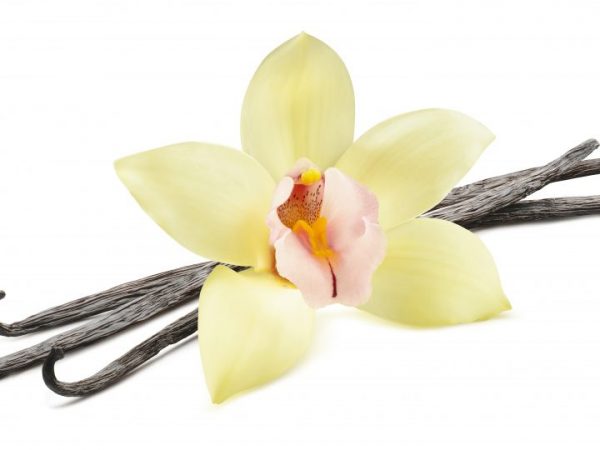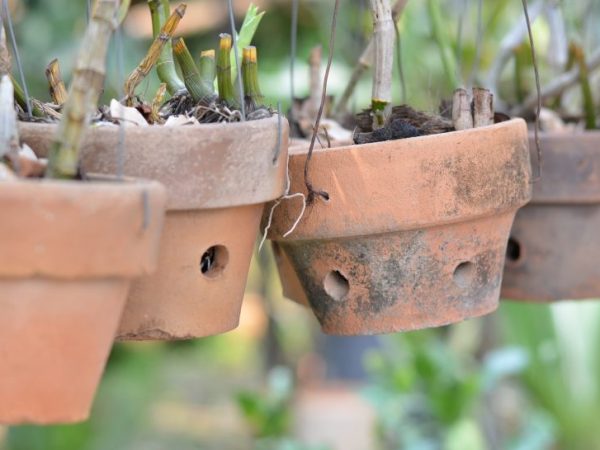Vanilla orchid care at home
Vanilla orchid has an important feature - the fruits of the plant are edible, which distinguishes it from other species.

Orchid Vanilla
Description of the variety
The vanilla orchid includes more than 100 species, most of which are epiphytes (often attached to other plants, feeding on the humidity of the air). Only two species are fertile and produce vanilla seeds, but it is unrealistic to grow them at home. The rest of the types are distinguished by a gorgeous look and a pleasant smell, and are excellent for decorating rooms.
The ancestor of the variety was Central America, but is grown on all continents of the world. There are also wild species that grow on the islands of Bourbon, Java, Mauritius.
Appearance:
- color of flowers - yellow, white, light green;
- leaves are oval, green;
- has a pleasant aroma;
- has aerial roots near the shoots;
- often grow a flower in a pots.
Growing
To grow a healthy and beautiful plant, you need to create the right living conditions.
The Vanilla Orchid is a climbing flower, so it needs strong support. A special plant stand is suitable for this.
Vanilla orchid is picky to care for. Basic conditions for growing:
- air humidity (in winter - 75%, in summer - 90%);
- air temperature from 28 ° С;
- good lighting (the side should be sunny, do not take root in the shade).
Choice of substrate and pot
For an orchid to feel comfortable, it needs a special, richer substrate than ordinary plants. Charcoal, peat, moss and wood bark should be added to the soil. The main feature of the substrate is lightness and breathability. It takes root well in the soil of peat and coconut fiber.
The pot should be made of either clay or plastic. Florists recommend using special baskets for the Vanilla Orchid.
Moisten the soil before planting. Plant carefully, burying only the roots, leaving the stem on the surface. In order for the sprout to adapt, it is placed in a plastic bag daily for 15-20 minutes, until the stems begin to sprout.

Orchid Pot Vanilla
Watering
Water the flower if the top ball of the earth is dry. But if the root system dries up, then the plants will die.
The water is used clean, at room temperature. Florists advise using warm sprinkling once a week. There is also a way to water by submerging the pot in water.
Top dressing
It is recommended to fertilize the orchid regularly (every two to three weeks). Fertilizers should be specially designed for the plant, and used strictly according to the instructions on the package, so as not to harm the flower.
Foliar dressing is done by spraying with special fertilizers for this variety.
Transplant and pruning
Florists recommend replanting a flower every year in the spring, because the soil loses its beneficial properties.
The first step is to carefully remove the flower from the pot without damaging the root system.If one of the roots is broken, sprinkle it with charcoal. The pot shouldn't be much different in size.
Cut off the tops so that the flower actively develops and grows, they can be used to plant a new flower). Thanks to this, it rejuvenates and sprouts new growth. A special preparation or activated carbon must be applied to the cut site.
Diseases and pests
Frequent diseases and pests:
- red spider mite;
- mealybugs;
- root and stem rot
- burns;
- anthracnose (fungus);
- late blight (fungus);
It is extremely difficult to meet pests. Most often, diseases are manifested due to improper care. Most often this happens due to overdrying or transfusion of flowers. In both cases, the root system begins to die.
Burns are also common on the leaves. This indicates that direct sunlight falls on the sheets. At the first symptoms of a fungus, a fungicide should be used.
Conclusion
Vanilla Orchid has a pleasant scent and looks gorgeous. This is what attracts most flower growers.
When planting, it is worth focusing on the planting capacity, substrate and the location of the flowerpot. A home grown vanilla orchid will be lush and strong. Active growth requires a humid warm climate in the apartment.


